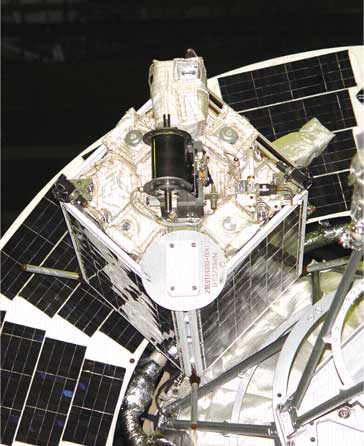
Tatiana – a supersmall satellite is manufactured by Production Corporation “Polyot” (Omsk, Russia) in the interests of Lomonosov Moscow State University. Tatiana-1 was launched on January 22, 2004 on the eve of the University’s 250th anniversary. For years of its work, it successfully studied circumterrestrial space, registered space flow of electrons, protons and alpha particles and made measurements of ultraviolet radiation of the atmosphere.
The scientific equipment “Tatiana” is developed for the detection and registration of the abnormal physical phenomena resulted from seismic activity, for their operative analysis and selection of the strong earthquakes precursors, and also for the global monitoring of the abnormal seismogenic phenomena and their consequences.
The Universitetsky-Tatyana satellite was being tracked by two ground stations, in Kaluga and in Moscow State University.
NASA Catalog: 32953
Downlink
435.315 und 435.215 MHz CW und FM (Data)
Status
nicht aktiv
On 6 March 2007, around 2100 UTC, the satellite stopped transmitting data, at least according to a diagram available on the MSU web site. MSU officials before the launch had said the expected life time of Universitetsky would be one to three years. Considering the fact that the spacecraft had been operational for more than two years, it wouldn’t be unusual if it stopped working after this period of time. Russian news agencies about one month later quoted unnamed Russian “space experts” as saying this failure may have been the result of some kind of U.S. “military experiment.” U.S. officials immediately dismissed those reports.
Russian space agency Roskosmos issued a statement saying such an attack was unlikely. Because Universitetsky was a student satellite, a more likely scenario is that someone uplinked an incorrect command, the agency said.


Payload
The payload of the Universitetskiy satellite includes groups of detectors of charged particle flux measurements (BD1-BD4 and BA); UV-emission detectors: 300-400 nm wavelength (DUV); information units that record and transmit scientific information from the detecting units to the auxiliary units, which in turn transmit it to the ground-based receiving stations.<(p>
Detectors on the Tatiana-1 satellite measured a smoothly varying intensity of UV radiation from the night-time atmosphere in the nadir direction and the intensity of the energetic electron flux at the orbit. At high latitudes the UV intensity in the auroral oval is interpreted as being due to electrons penetrating into the atmosphere. At middle latitudes the UV intensity is an order of magnitude less and more data are needed to reveal the origin of this radiation. Millisecond flashes of UV radiation were observed. The flashes’ energy, temporal profile and global distribution are similar to these parameters for Transient Luminous Events (TLEs). These studies will be continued aboard the next satellite Tatiana-2.
Links und weitere Informationen

http://cosmos.msu.ru/eng/http://smdc.sinp.msu.ru